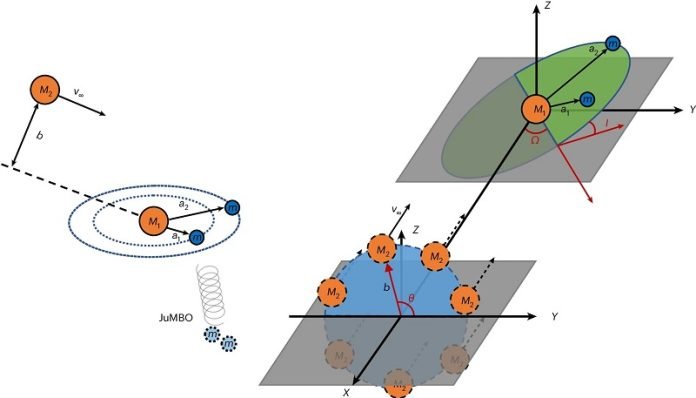
A groundbreaking study by astronomers using the James Webb Space Telescope has unveiled a new class of “free-floating” planets, challenging previous beliefs about how planets form in the universe.
These mysterious planets, known as Jupiter-mass Binary Objects (JuMBOs), do not orbit a star as most known planets do.
Instead, they orbit each other while drifting through space. The study, led by researchers from UNLV and Stony Brook University, was published on April 19 in the journal Nature Astronomy.
Traditionally, scientists believed that planets formed and lived around a star, much like Earth orbits the Sun.
However, the discovery of JuMBOs—huge planets floating freely through space in pairs—suggests there are more ways planets can exist than previously thought.
The research team, using sophisticated computer simulations called direct N-body simulations, explored how these unique planets could form.
Their findings indicate that JuMBOs likely originated in dense stellar clusters, areas of space where stars are packed closely together. In such crowded conditions, gravitational forces between stars are strong enough to eject giant planets from their home systems.
“Our simulations show that these giant planets were likely thrown out of their original homes by gravitational forces, remaining bound to each other as they travel through space,” explained Yihan Wang, a postdoctoral fellow at UNLV and the study’s corresponding author. This means that instead of orbiting a star, these planet pairs continue to orbit each other.
This new model suggests that such free-floating planets could be more common than scientists previously believed, especially in densely populated star clusters.
The characteristics of these planet pairs, like how far apart they are and how they move around each other, also give scientists new insights into the extreme conditions under which planets can form.
Rosalba Perna, a co-author of the study and a professor at Stony Brook University, noted, “This research highlights the importance of dynamic interactions between stars in influencing planetary systems, particularly in dense environments.”
The findings not only expand our understanding of planetary formation but also pave the way for future observations with the James Webb Space Telescope. These observations may further confirm the team’s findings and help refine theories about how planets develop.
Zhaohuan Zhu, a UNLV astrophysicist and co-author of the study, emphasized the significance of their findings, “This helps us challenge and refine what we thought we knew about how giant planets form.
We expect that future data from the telescope will provide even more insights, helping us to develop new theories of planetary evolution.”
This exciting discovery opens up new possibilities for understanding the diversity and dynamics of planets in our galaxy, suggesting that the universe may be filled with even more varied and intriguing planetary systems than we had imagined.
Source: University of Nevada, Las Vegas.



